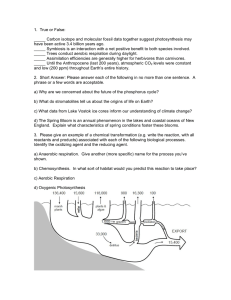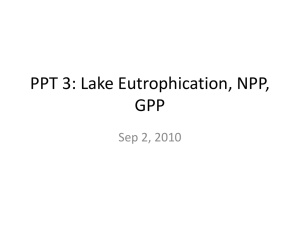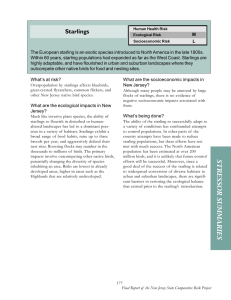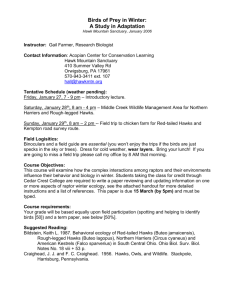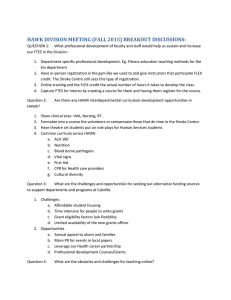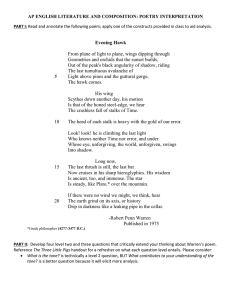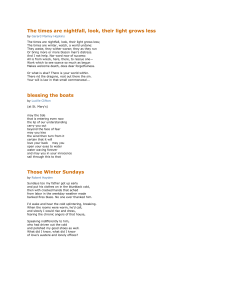Document 13497138
advertisement
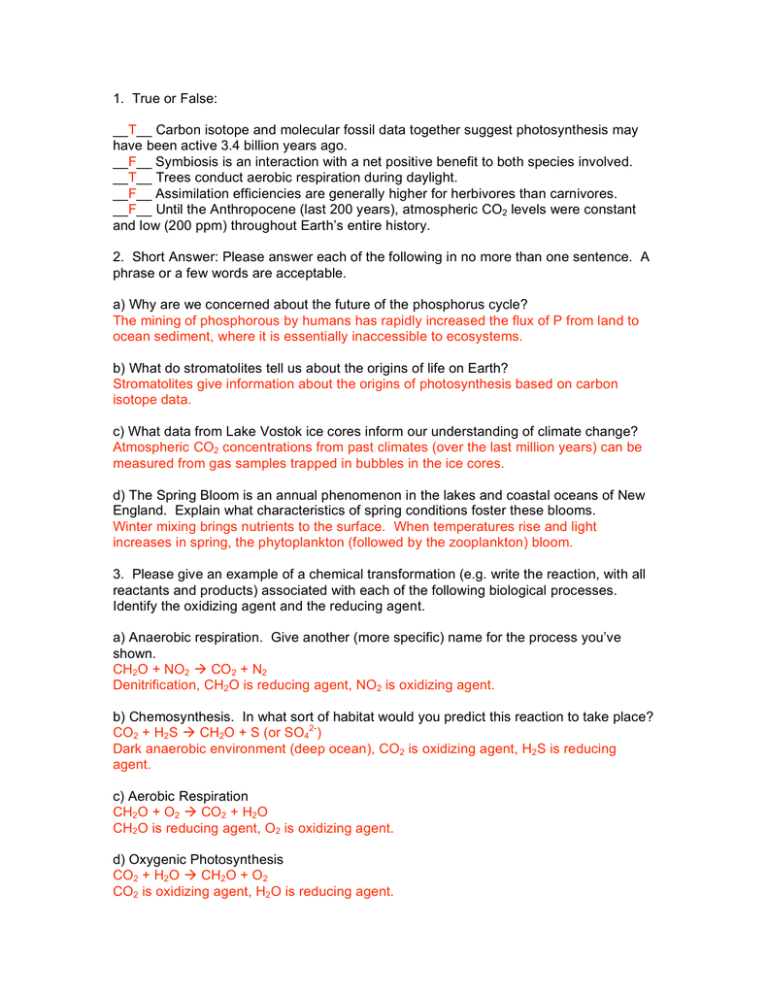
1. True or False: __T__ Carbon isotope and molecular fossil data together suggest photosynthesis may have been active 3.4 billion years ago. __F__ Symbiosis is an interaction with a net positive benefit to both species involved. __T__ Trees conduct aerobic respiration during daylight. __F__ Assimilation efficiencies are generally higher for herbivores than carnivores. __F__ Until the Anthropocene (last 200 years), atmospheric CO2 levels were constant and low (200 ppm) throughout Earth’s entire history. 2. Short Answer: Please answer each of the following in no more than one sentence. A phrase or a few words are acceptable. a) Why are we concerned about the future of the phosphorus cycle? The mining of phosphorous by humans has rapidly increased the flux of P from land to ocean sediment, where it is essentially inaccessible to ecosystems. b) What do stromatolites tell us about the origins of life on Earth? Stromatolites give information about the origins of photosynthesis based on carbon isotope data. c) What data from Lake Vostok ice cores inform our understanding of climate change? Atmospheric CO2 concentrations from past climates (over the last million years) can be measured from gas samples trapped in bubbles in the ice cores. d) The Spring Bloom is an annual phenomenon in the lakes and coastal oceans of New England. Explain what characteristics of spring conditions foster these blooms. Winter mixing brings nutrients to the surface. When temperatures rise and light increases in spring, the phytoplankton (followed by the zooplankton) bloom. 3. Please give an example of a chemical transformation (e.g. write the reaction, with all reactants and products) associated with each of the following biological processes. Identify the oxidizing agent and the reducing agent. a) Anaerobic respiration. Give another (more specific) name for the process you’ve shown. CH2O + NO2 • CO2 + N2 Denitrification, CH2O is reducing agent, NO2 is oxidizing agent. b) Chemosynthesis. In what sort of habitat would you predict this reaction to take place? CO2 + H2S • CH2O + S (or SO42-) Dark anaerobic environment (deep ocean), CO2 is oxidizing agent, H2S is reducing agent. c) Aerobic Respiration CH2O + O2 • CO2 + H2O CH2O is reducing agent, O2 is oxidizing agent. d) Oxygenic Photosynthesis CO2 + H2O • CH2O + O2 CO2 is oxidizing agent, H2O is reducing agent. 4. Above is the energy flow diagram for a Georgia salt marsh (gC m-2 yr-1). a) Calculate the gross primary production (GPP), net primary production (NPP), and net community production (NCP) for the entire marsh ecosystem. Show all your work. GPP is the total flux of energy into a system, not considering any losses from respiration. GPP = 136,400 + 15,600 = 152,000 gC m-2 yr-1 NPP is GPP minus losses to respiration by autotrophs (marsh plants and algae). NPP = 152,000 – 118,000 = 34,000 gC m-2 yr-1 NCP is NPP minus losses to respiration by heterotrophs (grazers, predators, and bacteria). NCP = 34,000 – 900 – 16,300 – 100 = 16700 gC m-2 yr-1 b) About half of the NPP is exported by tides into surrounding marine systems in the form of organisms, particulate detritus and dissolved organic material. What is the fate of the NPP that is not respired and not exported? (3pts) NPP that is not exported and is not respired will remain in the marsh as accumulated biomass, most likely as growth in marsh plants or detrital sediments. c) How many gC m-2 yr-1 experience the fate described in part b.? (2 pts) NPP minus respiration minus export is NCP that remains in ecosystem. This is equal to 16700 – 15400 = 1300 gC m-2 yr-1 5. Identify which member of each of the following pairs, in general, has the greatest diversity of species. Defend your answer with a sentence or two. a) A meadow with a Simpson’s Index of 0.215 or a meadow with a Simpson’s index of 0.618? A Simpson’s Index of 0.618. SI = 1 – D. D is a measure of the probability that, after you have randomly chosen one organism, the next organism you randomly choose will be of the same species. The higher D, the lower the diversity; therefore, a low SI corresponds to a low diversity. b) A large island close to the mainland, or a small island far from the mainland (both at equilibrium)? Provide two reasons. (Hint: you may use a graph in your answer.) The large island close to the mainland. Immigration rate is higher on the large, close island because (1) the island is closer to the mainland, so organisms do not have to travel as far, and (2) the island is larger, so it is a bigger target (the “target effect”). Extinction rate is lower on the large, close island because (1) the island is larger so it can support larger populations and is likely to have a wider variety of niches for organisms to differentiate into and fill, and (2) the island is closer, so even if populations approach extinction, they might be bolstered by immigration from the mainland (the “rescue effect”). c) A forest at 10°N latitude (near the equator) or a forest at 70°N latitude (near the pole)? The forest at 10ºN latitude. Biodiversity correlates with latitude, with higher diversity near the equator. This is because the climate is more moderate, so more organisms are capable of surviving than would survive the harsher, northern conditions. There are also more niches available at lower latitudes because GPP tends to be higher and conditions are less stressful for primary producers. Organisms can differentiate by competition. d) An ecosystem with high gross primary productivity, or an ecosystem with low gross primary productivity? The ecosystem with high GPP. High GPP correlates with high diversity. In a high GPP environment, you are more likely to have many different niches for organisms to fill, reducing the degree of competition. Also, higher GPP can support more trophic levels, which may increase diversity. Bonus: Is “sustainable growth” ever possible? Defend your response using information from class materials. Begin with a one-sentence definition of sustainability. Definition of sustainability must include some discussion of rate (i.e., removal rate must not exceed replacement rate) and timescale (i.e. over many human lifespans, or indefinitely). Sustainable growth may be possible when some process/population size is well below the carrying capacity. Ultimately, though, it seems that the Earth’s carrying capacity will impose a limit on growth, i.e. no matter how many technological innovations we have, there will be a “stopping point” somewhere. At any rate, humanity seems to be quite far from sustainable growth given its dependence on depleting natural resources, such as fossil fuels. 6. The Lotka-Volterra Competition Model is: $ K " N1 " #N 2 ' dN1 = r1N1& 1 ) dt K1 % ( ! $ K " N 2 " #N1 ' dN 2 = r2 N 2 & 2 ) dt K2 % ( a) According to the model, there are four possible outcomes with respect to two competing species, N1 and N2. Draw the four different possible equilibrium plots of N2 vs. N1 that show these outcomes. For each plot, label the axes, show the x and y intercepts ! for the isoclines, and clearly label the equilibrium outcome. N2 N2 K1/α Stable Equilibrium K2 K1/α K2 Stable Equilibrium K2/β N2 K1 N1 K1 K2/β N1 N2 Stable Equilibrium K2 K1/α Stable Equilibrium Unstable Equilibrium K1/α K2 Stable Equilibrium K2/β K1 N1 K1 K2/β N1 b) List three of the assumptions of this model. Homogeneous environment; no migration; carrying capacity constant; direct competition for a resource; linear relationship between density and growth rate; no time lags; stable age distribution c) In one sentence, state the Competitive Exclusion Principle. Complete competitors cannot coexist (in other words, if two species have 100% overlap in their niche, one will outcompete the other and drive it to extinction). d) Are all of your plots above completely consistent with the competitive exclusion principle? Which ones? Why or why not? If not, suggest some ecological reasons for why this inconsistency might occur. The plot on the lower right is inconsistent because it shows a case where both species coexist. This might occur when species do not share exactly the same niche, i.e. they divide up the resource spatially or temporally, or depend upon a slightly different set of resources. 7. Imagine that you are studying the effects of red-tailed hawk predation on the starling population of MIT’s west campus. Suppose that hawk and starling populations are governed by the following Lotka-Volterra predation-prey equations: dV = 0.1V " 0.0005PV dt ! dP = 0.001VP " 0.3P dt a) If initial population sizes are 100 hawks and 200 starlings, what are the short-term population dynamics (e.g. population trajectories of hawks and starlings) predicted by the model? ! Hawk population is decreasing, starling population is increasing. You can solve this problem graphically (by calculating the isoclines, plotting, and demonstrating that the starting conditions (100 hawks and 200 starlings) falls in the quadrant where starling populations are increasing and hawk populations are decreasing, or you can solve the problem analytically: dV/dt = rV – αPV dV/dt = 0.1*200 – 0.0005*100*200 dV/dt = 10 dP/dt = βVP – qP dP/dt = 0.001*100*200 – 0.3*100 dP/dt = -10 b) Imagine that the hawk’s response to starlings is governed by the following Holling curve. Label the axes of the curve. What type of Holling Curve (I, II, or III) is this? Identify the regions of the curve where the hawk is limited by search time. Identify the regions where the hawk is limited by handling time. Limited by handling time Limited by search time Type II curve c) Imagine that the population of MIT pigeons has increased due to sympathetic feeding by campus visitors. Because the pigeons are slower and juicier, the hawks decide to hunt them, instead. What new Holling Response Curve will the hawks show when hunting starlings? Why? The hawks will show a Type III response to starlings. When the starling population is low, the hawks will hunt pigeons because they are the preferred prey. When the starling population increases beyond a certain point, the hawks will begin the hunt them because they are so abundant. Eventually, as in Type II, the predator response will saturate (gradually, due to handling time limits). d) Given that starlings eat insects and insects eat grass, what trophic level do you expect the hawk to be at if it eats only starlings? Hawk is TL=4 e) Given that pigeons eat seeds, what trophic level do you expect the hawk to be at if its diet is 70% pigeons and 30% starlings? Hawk is TL=3.3 f) If you assume a 10% trophic transfer efficiency in all links of the food web, how much primary productivity (in kg) would it take to make a 3 kg red-tailed hawk that eats only starlings? (0.1)3*x = 3 x = 3000 kg 8. Over the past 200 years, the human population on Earth has been in the process of a “demographic transition”, during which the population of humans has increased dramatically. a) What are the underlying causes of the population explosion that occurs during a demographic transition? Sketch the graph, in terms of births per person and deaths per person, as a function of time. Stage 1 Preindustrial Stage 2 Transitional Stage 3 Industrial Stage 4 Postindustrial High 70 60 Total population 50 Relative population size Birth rate and death rate (numberper 1,000 per year) 80 Birth rate 40 30 Death rate 20 10 0 Low Low growth rate Increasing growth rate Very high growth rate Decreasing growth rate Low growth rate Zero growth rate Negative growth rate Time Image by MIT OpenCourseWare. b) What technological developments are responsible for the shapes of these curves? Death rate decrease: Modern medicine increasing lifespans and decreasing infant mortality. Agricultural technology improving yields and decreasing starvation. Sanitation practices reducing infectious disease. Birth rate decrease: Gradual decrease a reflection of changes in societal norms and a reduced need for children because those born have a higher probability of surviving into adulthood. c) Sketch the age distribution (number of people in different age groups) you would expect to see in (1) a population that is growing rapidly, and (2) a population that is just replacing itself. The figure on the bottom shows a population that is growing rapidly. The figure on top shows a population in approximate steady state. MIT OpenCourseWare http://ocw.mit.edu 1.018J / 7.30J Ecology I: The Earth Fall 2009 For information about citing these materials or our Terms of Use, visit: http://ocw.mit.edu/terms.
